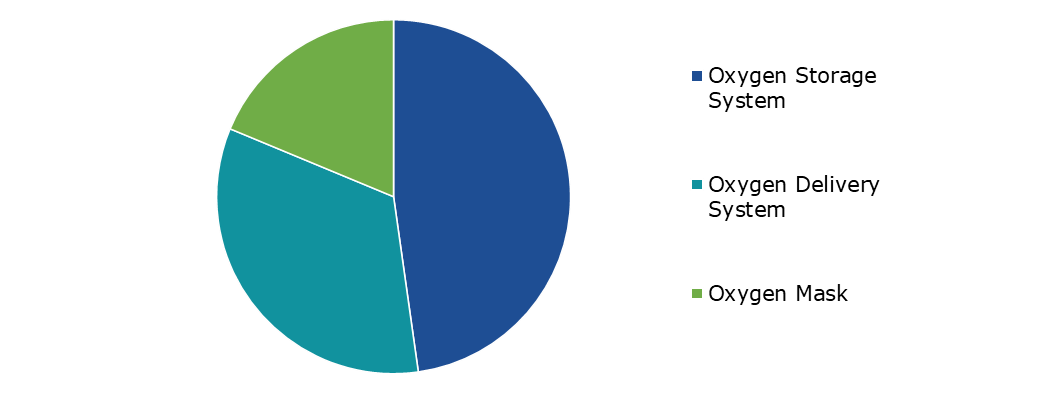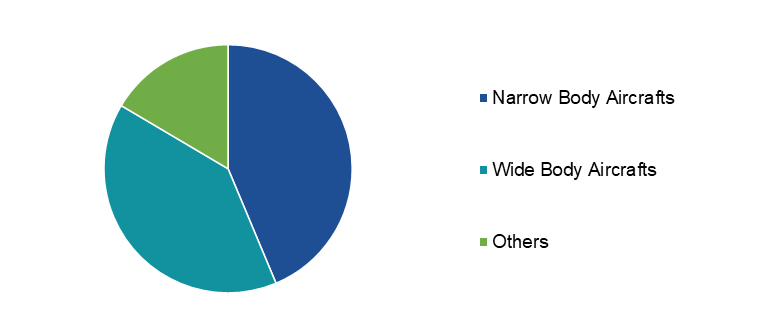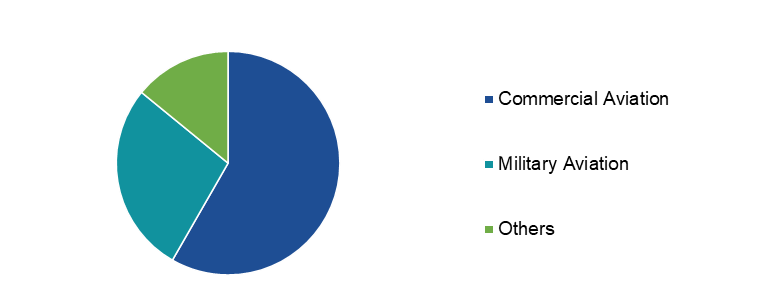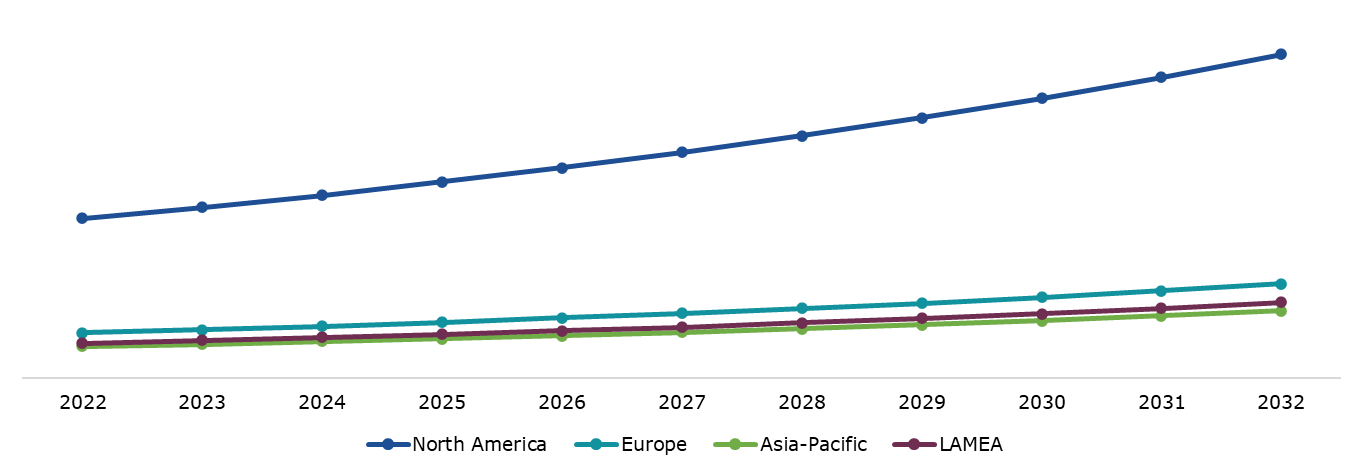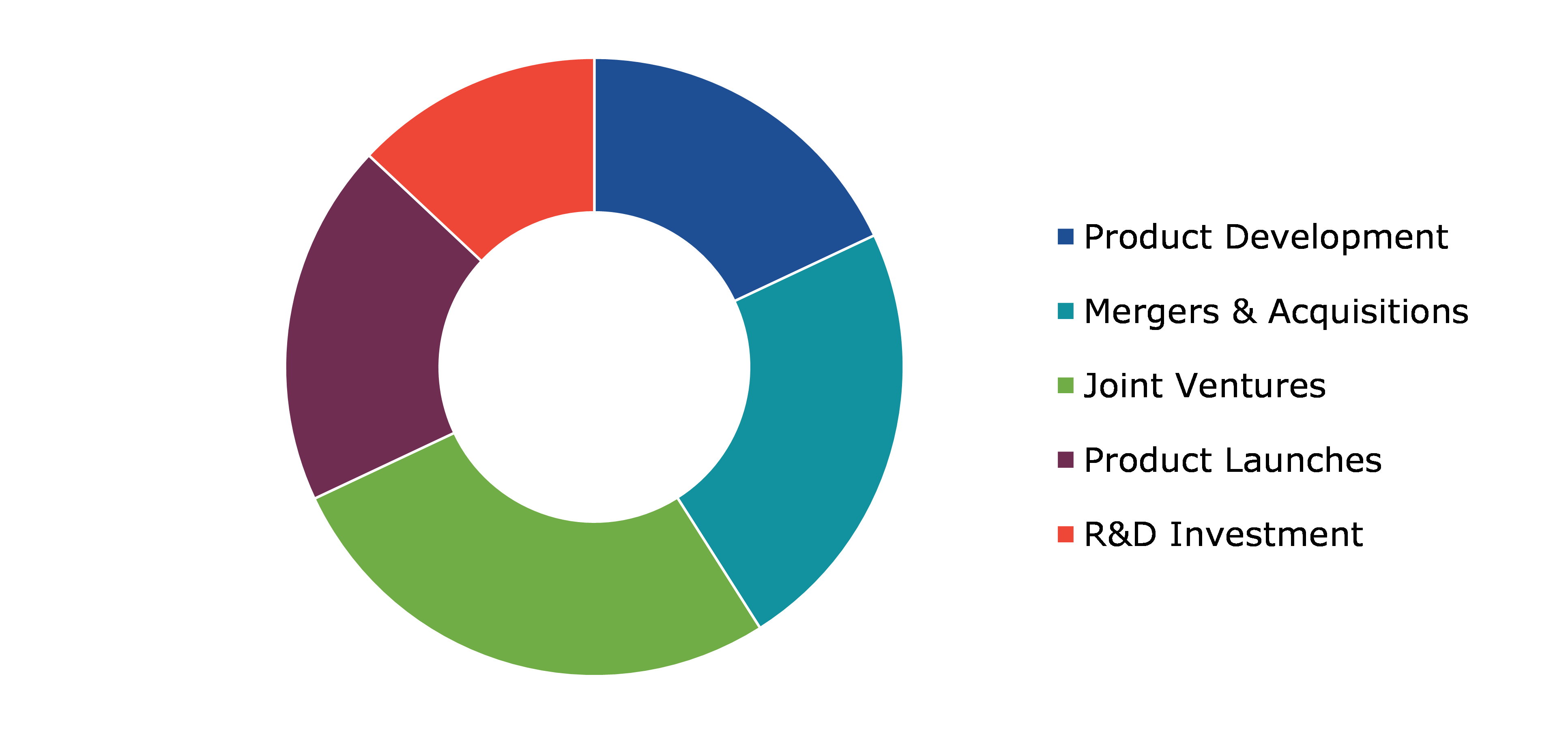Aircraft Oxygen System Market Report
RA09198
Aircraft Oxygen System Market by Component (Oxygen Storage System, Oxygen Delivery System, and Oxygen Mask), System (Passenger Oxygen System and Crew Oxygen System), Aircraft Type (Narrow Body Aircrafts, Wide Body Aircrafts, and Others), End-use (Commercial Aviation, Military Aviation, and Others), and Region (North America, Europe, Asia-Pacific, and LAMEA): Global Opportunity Analysis and Industry Forecast, 2023-2032
Aircraft Oxygen System Overview
Aircraft oxygen systems play an important role in maintaining the well-being of passengers and crew during flight, particularly at high altitudes where atmospheric pressure drops. These systems are activated when the aircraft operates above 12,000 feet or in emergency scenarios. The human body's reliance on oxygen for metabolism necessitates a pressurized cabin to ensure a sufficient supply at elevated altitudes. The design of aircraft oxygen systems is tailored to regulate and adjust oxygen levels as required. In light twin-engine aircraft, oxygen cylinders are proficiently adapted to supply a system through regulators and tubing. For high-performance aircraft, built-in oxygen systems serve this purpose. Individual oxygen supply is facilitated through breathing stations in the passenger area, allowing each passenger to connect a pipe and mask as needed.
The use of gaseous oxygen is common in aircraft, with variations depending on the aircraft type. Transport aircraft in particular are equipped with an additional gaseous oxygen system that acts as a backup for cabin pressurization. In general, aircraft oxygen systems are indispensable for mitigating the effects of reduced atmospheric pressure, ensuring passengers and crew receive a consistent and adequate supply of oxygen during flight, contributing to their safety and well-being.
Global Aircraft Oxygen System Market Analysis
The global aircraft oxygen system market size was $2,280.1 million in 2022 and is predicted to grow with a CAGR of 7.6%, by generating a revenue of $4,726.3 million by 2032.

Source: Research Dive Analysis
Increasing Passenger Traffic to Drive the Market Revenue Growth
The rise in global air travel can be attributed to numerous factors that have significantly impacted the aviation industry in recent years. The increase in low-cost carriers has played a pivotal role, nearly doubling their market share. These budget-friendly airlines have made air travel more accessible to a broader segment of the population, attracting a growing number of passengers seeking affordable options, this has correspondingly led to an increase in the demand for aircraft oxygen system in aircrafts. In addition, the expansion of the global middle class has also contributed to the rise in air travel. As more individuals attain higher income levels, a greater portion of the population can now afford air transportation. This demographic shift has led to an increased demand for flights, driving the growth of the airline industry and correspondingly the aircraft oxygen system demand. Furthermore, the upward growth of air travel is the substantial investment in airport infrastructure. Globally, there has been a notable increase in spending on airport facilities, enhancing their capacity to handle more flights and passengers. This expansion in infrastructure has played a crucial role in accommodating the escalating demand for air travel and has contributed to the overall growth of the aircraft oxygen system market.
Stringent Regulations for Air Safety and Limited Production Capacity to Restrain the Market Growth
The aircraft oxygen system market has encountered obstruction in its growth due to a combination of stringent regulations for air safety and limited production capacity. The aviation industry is subject to rigorous safety standards, with regulatory bodies imposing stringent requirements to ensure the well-being of passengers and crew. These regulations often necessitate advanced and highly reliable oxygen systems in aircraft to mitigate risks associated with emergencies such as decompression or cabin depressurization. Stringent regulatory frameworks which continuously evolve to address emerging safety concerns, demand continuous advancements in aircraft systems. Compliance with these regulations involves extensive testing, certification processes, and adherence to specific standards, which can pose challenges for manufacturers in terms of time and resources. This regulatory environment creates a barrier to entry for new players and requires existing manufacturers to invest significantly in R&D to meet and exceed the prescribed safety standards. Moreover, the growth of the aircraft oxygen system market is also impacted by limitations in production capacity. Manufacturing sophisticated and high-quality oxygen systems for aircraft involves complex engineering processes and precision manufacturing. The limited production capacity within the industry can result in challenges related to meeting the increasing demand for these systems, especially as air travel continues to expand globally.
Integration of Internet of Things (IoT) Technology in Aircraft Oxygen Systems to Drive Excellent Opportunities
The incorporation of Internet of Things (IoT) technology into aircraft oxygen systems represents a transformative advancement in aviation safety and efficiency. By enabling real-time monitoring and data collection, this integration facilitates predictive maintenance, early fault detection, and enhanced overall system performance. Airlines can now remotely access and monitor the status of their aircraft's oxygen systems, transforming into a new era of proactive maintenance practices. The connectivity provided by IoT ensures that crucial data regarding oxygen system condition is constantly accessible. The real-time monitoring capability enables airlines to identify potential issues before they worsen, leading to a significant reduction in unscheduled downtime. With the ability to detect faults on an early basis, airlines can implement timely maintenance interventions, preventing disruptions to flight schedules and enhancing passenger safety. Moreover, the utilization of IoT technology in aircraft oxygen systems enhances operational efficiency by providing comprehensive insights into system performance. Airlines can analyze data trends, optimize resource allocation, and make informed decisions to improve overall operational effectiveness.
Global Aircraft Oxygen System Market, by Component, 2022
Source: Research Dive Analysis
The oxygen storage system sub-segment accounted for the highest market share in 2022. Oxygen storage system’s dominance in the aircraft oxygen system is attributed to its reliability, efficiency, and compact design, addressing the crucial need for space optimization in aviation. These systems employ advanced technology to store oxygen in compressed or liquid forms, ensuring a controlled release during emergencies. The compact design is vital for integration into the limited space available on aircraft. The efficiency in space utilization is important as it offers a solution that does not compromise safety standards. In critical phases of flight, such as takeoff and landing, the prominence of oxygen storage systems becomes evident. They guarantee a secure and reliable oxygen supply when needed, contributing significantly to the overall safety and well-being of passengers on board. The continuous evolution of these systems highlights their importance in maintaining a controlled and sustained oxygen supply during emergency circumstances.
Global Aircraft Oxygen System Market, by System, 2022
Source: Research Dive Analysis
The passenger oxygen system sub-segment accounted for the highest market share in 2022. The safety and wellbeing of passengers during flights are guaranteed by the passenger oxygen system (POS). When an emergency occurs, like cabin depressurization, this component is crucial in ensuring a steady and regulated oxygen delivery. In order to effectively provide passengers with oxygen masks when necessary, the POS is specifically made to adhere to strict aviation safety regulations. Under emergency conditions, oxygen masks are released from overhead compartments by the POS, which drop down automatically. In high altitudes when oxygen levels may be inadequate, this guarantees passengers swift accessibility and safe breathing. With a focus on passenger safety and a reduction of hypoxia-related dangers, the system is precisely developed to enable a smoothly functioning and prompt response.
Global Aircraft Oxygen System Market, by Aircraft Type, 2022
Source: Research Dive Analysis
The narrow body aircraft sub-segment accounted for the highest market share in 2022. The demand for narrow-body aircraft is escalating at a progressive rate owing to the extensive usage of narrow-body aircraft for short to medium haul flights, which requires effective and dependable oxygen systems for passenger safety. This has led to an increase in demand for aircraft oxygen system for these type of aircrafts. The widespread use of narrow-body aircraft, like the well-known Boeing 737 and Airbus A320 series, emphasizes how important oxygen systems are to maintaining the safety of both passengers and crew on airplanes. This sub-segment has high demand for technologically advanced oxygen systems, which is in line with the aviation industry's goal of raising safety requirements.
Global Aircraft Oxygen System Market, by End-use, 2022
Source: Research Dive Analysis
The commercial aviation sub-segment accounted for the highest market share in 2022. The dominance of this sub-segment is highlighted by the widespread deployment of aircraft oxygen systems in large passenger planes, highlighting the vital need to uphold a controlled and breathable atmosphere at high altitudes. This sector gains a competitive edge due to the substantial volume of passengers and flights, compelling the efficient utilization of oxygen systems to adhere to safety standards and regulatory mandates. Consequently, the global market for aircraft oxygen systems is notably shaped by the dynamics and demands of commercial aviation. The emphasis on maintaining a safe and regulated environment in high-altitude travel positions the commercial aviation sub-segment as a driving force in advancing and influencing the development of aircraft oxygen systems on a global scale.
Global Aircraft Oxygen System Market Size & Forecast, by Region, 2022-2032 ($Million)
Source: Research Dive Analysis
The North America aircraft oxygen system market generated the highest revenue in 2022. North America’s dominance in the global aircraft oxygen system market is based due to the substantial presence of major aircraft manufacturers, such as Boeing and Bombardier. The strategic positioning of these industry leaders enhances the region's influence. The region’s commitment toward innovation is evident through continuous investments in expanding commercial, military, and regional aircraft fleets. This proactive approach not only solidifies the region as a hub for aircraft production but also drives the demand for advanced oxygen systems in aviation applications. The synergy of established industry players, technological innovation, and consistent investments establishes North America as a major force shaping the trajectory of the global aircraft oxygen system market, ensuring safety and efficiency in diverse aviation operations.
Competitive Scenario in the Global Aircraft Oxygen System Market
Product launch, investment, and acquisition are common strategies followed by major market players. For instance, in January 2022, Caeli Nova concluded its Series A funding round, securing a substantial $8.39 million investment. The company specializes in the development of an aircraft emergency oxygen system. Unlike traditional technologies, Caeli Nova's system aims to surpass existing limitations, offering enhanced functionality for passenger aircraft. The major advantage of Caeli Nova's emergency oxygen system lies in its ability to mitigate challenges associated with current technologies. In addition, the system confirms a notable reduction in costs and carbon emissions for airlines. One of the key mechanisms facilitating these benefits is the system's capability to enable aircraft to opt for the most direct routes during flights. This optimization not only enhances operational efficiency but also aligns with a broader industry trend towards more environmentally sustainable practices. Moreover, with the newly acquired funds, the company is poised to make significant improvements in bringing its technology to market, potentially reshaping the landscape of aircraft emergency oxygen systems. As the aviation industry continues to prioritize efficiency and sustainability, Caeli Nova's advancements are expected to contribute to a more streamlined and environmentally conscious air travel experience.
Some of the leading aircraft oxygen system market players are Aerox, Technodinamika, Rockwell Collins, Inc, Cobham plc, Diehl Stiftung & Co. KG, Aviation Oxygen Systems Inc, Adams Rite Aerospace Inc, Safran, Essex Industries, Inc, and Precise Flight, Inc.
| Aspect | Particulars |
| Historical Market Estimations | 2020-2021 |
| Base Year for Market Estimation | 2022 |
| Forecast Timeline for Market Projection | 2023-2032 |
| Geographical Scope | North America, Europe, Asia-Pacific, and LAMEA |
| Segmentation by Component |
|
| Segmentation by System |
|
| Segmentation by Aircraft Type |
|
| Segmentation by End-use |
|
| Key Companies Profiled |
|
Q1. What is the size of the global aircraft oxygen system market?
A. The size of the global aircraft oxygen system market was $2,280.1 million in 2022 and is projected to reach $4,726.3 million by 2032.
Q2. Which are the major companies in the aircraft oxygen system market?
A. Aerox, Technodinamika, Rockwell Collins, Inc, Cobham plc, Diehl Stiftung & Co. KG, Aviation Oxygen Systems Inc, Adams Rite Aerospace Inc, Safran, Essex Industries, Inc, and Precise Flight, Inc. are some of the key players in the global aircraft oxygen system market.
Q3. Which region, among others, possesses greater investment opportunities in the future?
A. Asia-Pacific possesses great investment opportunities for investors in the future.
Q4. What will be the growth rate of the Asia-Pacific aircraft oxygen system market?
A. The Asia-Pacific aircraft oxygen system market is anticipated to grow at 7.9% CAGR during the forecast period.
Q5. What are the strategies opted by the leading players in this market?
A. Continuous improvement and brand product differentiation are the two key strategies opted by the operating companies in this market.
Q6. Which companies are investing more in R&D activities?
A. Rockwell Collins, Inc, Cobham plc, Diehl Stiftung & Co. KG, and Aviation Oxygen Systems Inc are the companies investing more on R&D activities for developing new products and technologies.
1. Research Methodology
1.1. Desk Research
1.2. Real time insights and validation
1.3. Forecast model
1.4. Assumptions and forecast parameters
1.5. Market size estimation
1.5.1. Top-down approach
1.5.2. Bottom-up approach
2. Report Scope
2.1. Market definition
2.2. Key objectives of the study
2.3. Market segmentation
3. Executive Summary
4. Market Overview
4.1. Introduction
4.2. Growth impact forces
4.2.1. Drivers
4.2.2. Restraints
4.2.3. Opportunities
4.3. Market value chain analysis
4.3.1. List of raw material suppliers
4.3.2. List of manufacturers
4.3.3. List of distributors
4.4. Innovation & sustainability matrices
4.4.1. Technology matrix
4.4.2. Regulatory matrix
4.5. Porter’s five forces analysis
4.5.1. Bargaining power of suppliers
4.5.2. Bargaining power of consumers
4.5.3. Threat of substitutes
4.5.4. Threat of new entrants
4.5.5. Competitive Rivalry Intensity
4.6. PESTLE analysis
4.6.1. Political
4.6.2. Economical
4.6.3. Social
4.6.4. Technological
4.6.5. Legal
4.6.6. Environmental
4.7. Impact of COVID-19 on the Aircraft Oxygen System Market
4.7.1. Pre-covid market scenario
4.7.2. Post-covid market scenario
5. Aircraft Oxygen System Market Analysis, by Component
5.1. Overview
5.2. Oxygen Storage System
5.2.1. Definition, key trends, growth factors, and opportunities
5.2.2. Market size analysis, by region, 2022-2032
5.2.3. Market share analysis, by country, 2022-2032
5.3. Oxygen Delivery System
5.3.1. Definition, key trends, growth factors, and opportunities
5.3.2. Market size analysis, by region, 2022-2032
5.3.3. Market share analysis, by country, 2022-2032
5.4. Oxygen Mask
5.4.1. Definition, key trends, growth factors, and opportunities
5.4.2. Market size analysis, by region, 2022-2032
5.4.3. Market share analysis, by country, 2022-2032
5.5. Research Dive Exclusive Insights
5.5.1. Market attractiveness
5.5.2. Competition heatmap
6. Aircraft Oxygen System Market Analysis, by System
6.1. Overview
6.2. Passenger Oxygen System
6.2.1. Definition, key trends, growth factors, and opportunities
6.2.2. Market size analysis, by region, 2022-2032
6.2.3. Market share analysis, by country, 2022-2032
6.3. Crew Oxygen System
6.3.1. Definition, key trends, growth factors, and opportunities
6.3.2. Market size analysis, by region, 2022-2032
6.3.3. Market share analysis, by country, 2022-2032
6.4. Research Dive Exclusive Insights
6.4.1. Market attractiveness
6.4.2. Competition heatmap
7. Aircraft Oxygen System Market Analysis, by Aircraft Type
7.1. Overview
7.2. Narrow Body Aircrafts
7.2.1. Definition, key trends, growth factors, and opportunities
7.2.2. Market size analysis, by region, 2022-2032
7.2.3. Market share analysis, by country, 2022-2032
7.3. Wide Body Aircrafts
7.3.1. Definition, key trends, growth factors, and opportunities
7.3.2. Market size analysis, by region, 2022-2032
7.3.3. Market share analysis, by country, 2022-2032
7.4. Others
7.4.1. Definition, key trends, growth factors, and opportunities
7.4.2. Market size analysis, by region, 2022-2032
7.4.3. Market share analysis, by country, 2022-2032
7.5. Research Dive Exclusive Insights
7.5.1. Market attractiveness
7.5.2. Competition heatmap
8. Aircraft Oxygen System Market Analysis, by End-use
8.1. Overview
8.2. Commercial Aviation
8.2.1. Definition, key trends, growth factors, and opportunities
8.2.2. Market size analysis, by region, 2022-2032
8.2.3. Market share analysis, by country, 2022-2032
8.3. Military Aviation
8.3.1. Definition, key trends, growth factors, and opportunities
8.3.2. Market size analysis, by region, 2022-2032
8.3.3. Market share analysis, by country, 2022-2032
8.4. Others
8.4.1. Definition, key trends, growth factors, and opportunities
8.4.2. Market size analysis, by region, 2022-2032
8.4.3. Market share analysis, by country, 2022-2032
8.5. Research Dive Exclusive Insights
8.5.1. Market attractiveness
8.5.2. Competition heatmap
9. Aircraft Oxygen System Market, by Region
9.1. North America
9.1.1. U.S.
9.1.1.1. Market size analysis, by Component, 2022-2032
9.1.1.2. Market size analysis, by System, 2022-2032
9.1.1.3. Market size analysis, by Aircraft Type, 2022-2032
9.1.1.4. Market size analysis, by End-use, 2022-2032
9.1.2. Canada
9.1.2.1. Market size analysis, by Component, 2022-2032
9.1.2.2. Market size analysis, by System, 2022-2032
9.1.2.3. Market size analysis, by Aircraft Type, 2022-2032
9.1.2.4. Market size analysis, by End-use, 2022-2032
9.1.3. Mexico
9.1.3.1. Market size analysis, by Component, 2022-2032
9.1.3.2. Market size analysis, by System, 2022-2032
9.1.3.3. Market size analysis, by Aircraft Type, 2022-2032
9.1.3.4. Market size analysis, by End-use, 2022-2032
9.1.4. Research Dive Exclusive Insights
9.1.4.1. Market attractiveness
9.1.4.2. Competition heatmap
9.2. Europe
9.2.1. Germany
9.2.1.1. Market size analysis, by Component, 2022-2032
9.2.1.2. Market size analysis, by System, 2022-2032
9.2.1.3. Market size analysis, by Aircraft Type, 2022-2032
9.2.1.4. Market size analysis, by End-use, 2022-2032
9.2.2. UK
9.2.2.1. Market size analysis, by Component, 2022-2032
9.2.2.2. Market size analysis, by System, 2022-2032
9.2.2.3. Market size analysis, by Aircraft Type, 2022-2032
9.2.2.4. Market size analysis, by End-use, 2022-2032
9.2.3. France
9.2.3.1. Market size analysis, by Component, 2022-2032
9.2.3.2. Market size analysis, by System, 2022-2032
9.2.3.3. Market size analysis, by Aircraft Type, 2022-2032
9.2.3.4. Market size analysis, by End-use, 2022-2032
9.2.4. Spain
9.2.4.1. Market size analysis, by Component, 2022-2032
9.2.4.2. Market size analysis, by System, 2022-2032
9.2.4.3. Market size analysis, by Aircraft Type, 2022-2032
9.2.4.4. Market size analysis, by End-use, 2022-2032
9.2.5. Italy
9.2.5.1. Market size analysis, by Component, 2022-2032
9.2.5.2. Market size analysis, by System, 2022-2032
9.2.5.3. Market size analysis, by Aircraft Type, 2022-2032
9.2.5.4. Market size analysis, by End-use, 2022-2032
9.2.6. Rest of Europe
9.2.6.1. Market size analysis, by Component, 2022-2032
9.2.6.2. Market size analysis, by System, 2022-2032
9.2.6.3. Market size analysis, by Aircraft Type, 2022-2032
9.2.6.4. Market size analysis, by End-use, 2022-2032
9.2.7. Research Dive Exclusive Insights
9.2.7.1. Market attractiveness
9.2.7.2. Competition heatmap
9.3. Asia-Pacific
9.3.1. China
9.3.1.1. Market size analysis, by Component, 2022-2032
9.3.1.2. Market size analysis, by System, 2022-2032
9.3.1.3. Market size analysis, by Aircraft Type, 2022-2032
9.3.1.4. Market size analysis, by End-use, 2022-2032
9.3.2. Japan
9.3.2.1. Market size analysis, by Component, 2022-2032
9.3.2.2. Market size analysis, by System, 2022-2032
9.3.2.3. Market size analysis, by Aircraft Type, 2022-2032
9.3.2.4. Market size analysis, by End-use, 2022-2032
9.3.3. India
9.3.3.1. Market size analysis, by Component, 2022-2032
9.3.3.2. Market size analysis, by System, 2022-2032
9.3.3.3. Market size analysis, by Aircraft Type, 2022-2032
9.3.3.4. Market size analysis, by End-use, 2022-2032
9.3.4. Australia
9.3.4.1. Market size analysis, by Component, 2022-2032
9.3.4.2. Market size analysis, by System, 2022-2032
9.3.4.3. Market size analysis, by Aircraft Type, 2022-2032
9.3.4.4. Market size analysis, by End-use, 2022-2032
9.3.5. South Korea
9.3.5.1. Market size analysis, by Component, 2022-2032
9.3.5.2. Market size analysis, by System, 2022-2032
9.3.5.3. Market size analysis, by Aircraft Type, 2022-2032
9.3.5.4. Market size analysis, by End-use, 2022-2032
9.3.6. Rest of Asia-Pacific
9.3.6.1. Market size analysis, by Component, 2022-2032
9.3.6.2. Market size analysis, by System, 2022-2032
9.3.6.3. Market size analysis, by Aircraft Type, 2022-2032
9.3.6.4. Market size analysis, by End-use, 2022-2032
9.3.7. Research Dive Exclusive Insights
9.3.7.1. Market attractiveness
9.3.7.2. Competition heatmap
9.4. LAMEA
9.4.1. Brazil
9.4.1.1. Market size analysis, by Component, 2022-2032
9.4.1.2. Market size analysis, by System, 2022-2032
9.4.1.3. Market size analysis, by Aircraft Type, 2022-2032
9.4.1.4. Market size analysis, by End-use, 2022-2032
9.4.2. UAE
9.4.2.1. Market size analysis, by Component, 2022-2032
9.4.2.2. Market size analysis, by System, 2022-2032
9.4.2.3. Market size analysis, by Aircraft Type, 2022-2032
9.4.2.4. Market size analysis, by End-use, 2022-2032
9.4.3. Saudi Arabia
9.4.3.1. Market size analysis, by Component, 2022-2032
9.4.3.2. Market size analysis, by System, 2022-2032
9.4.3.3. Market size analysis, by Aircraft Type, 2022-2032
9.4.3.4. Market size analysis, by End-use, 2022-2032
9.4.4. South Africa
9.4.4.1. Market size analysis, by Component, 2022-2032
9.4.4.2. Market size analysis, by System, 2022-2032
9.4.4.3. Market size analysis, by Aircraft Type, 2022-2032
9.4.4.4. Market size analysis, by End-use, 2022-2032
9.4.5. Rest of LAMEA
9.4.5.1. Market size analysis, by Component, 2022-2032
9.4.5.2. Market size analysis, by System, 2022-2032
9.4.5.3. Market size analysis, by Aircraft Type, 2022-2032
9.4.5.4. Market size analysis, by End-use, 2022-2032
9.4.6. Research Dive Exclusive Insights
9.4.6.1. Market attractiveness
9.4.6.2. Competition heatmap
10. Competitive Landscape
10.1. Top winning strategies, 2022
10.1.1. By strategy
10.1.2. By year
10.2. Strategic overview
10.3. Market share analysis, 2022
11. Company Profiles
11.1. Aerox
11.1.1. Overview
11.1.2. Business segments
11.1.3. Product portfolio
11.1.4. Financial performance
11.1.5. Recent developments
11.1.6. SWOT analysis
11.2. Technodinamika
11.2.1. Overview
11.2.2. Business segments
11.2.3. Product portfolio
11.2.4. Financial performance
11.2.5. Recent developments
11.2.6. SWOT analysis
11.3. Rockwell Collins, Inc.
11.3.1. Overview
11.3.2. Business segments
11.3.3. Product portfolio
11.3.4. Financial performance
11.3.5. Recent developments
11.3.6. SWOT analysis
11.4. Cobham plc
11.4.1. Overview
11.4.2. Business segments
11.4.3. Product portfolio
11.4.4. Financial performance
11.4.5. Recent developments
11.4.6. SWOT analysis
11.5. Diehl Stiftung & Co. KG
11.5.1. Overview
11.5.2. Business segments
11.5.3. Product portfolio
11.5.4. Financial performance
11.5.5. Recent developments
11.5.6. SWOT analysis
11.6. Aviation Oxygen Systems Inc.
11.6.1. Overview
11.6.2. Business segments
11.6.3. Product portfolio
11.6.4. Financial performance
11.6.5. Recent developments
11.6.6. SWOT analysis
11.7. Adams Rite Aerospace Inc.
11.7.1. Overview
11.7.2. Business segments
11.7.3. Product portfolio
11.7.4. Financial performance
11.7.5. Recent developments
11.7.6. SWOT analysis
11.8. Safran
11.8.1. Overview
11.8.2. Business segments
11.8.3. Product portfolio
11.8.4. Financial performance
11.8.5. Recent developments
11.8.6. SWOT analysis
11.9. Essex Industries, Inc.
11.9.1. Overview
11.9.2. Business segments
11.9.3. Product portfolio
11.9.4. Financial performance
11.9.5. Recent developments
11.9.6. SWOT analysis
11.10. Precise Flight, Inc.
11.10.1. Overview
11.10.2. Business segments
11.10.3. Product portfolio
11.10.4. Financial performance
11.10.5. Recent developments
11.10.6. SWOT analysis
Personalize this research
- Triangulate with your own data
- Request your format and definition
- Get a deeper dive on a specific application, geography, customer or competitor
- + 1-888-961-4454 Toll - Free
- support@researchdive.com

